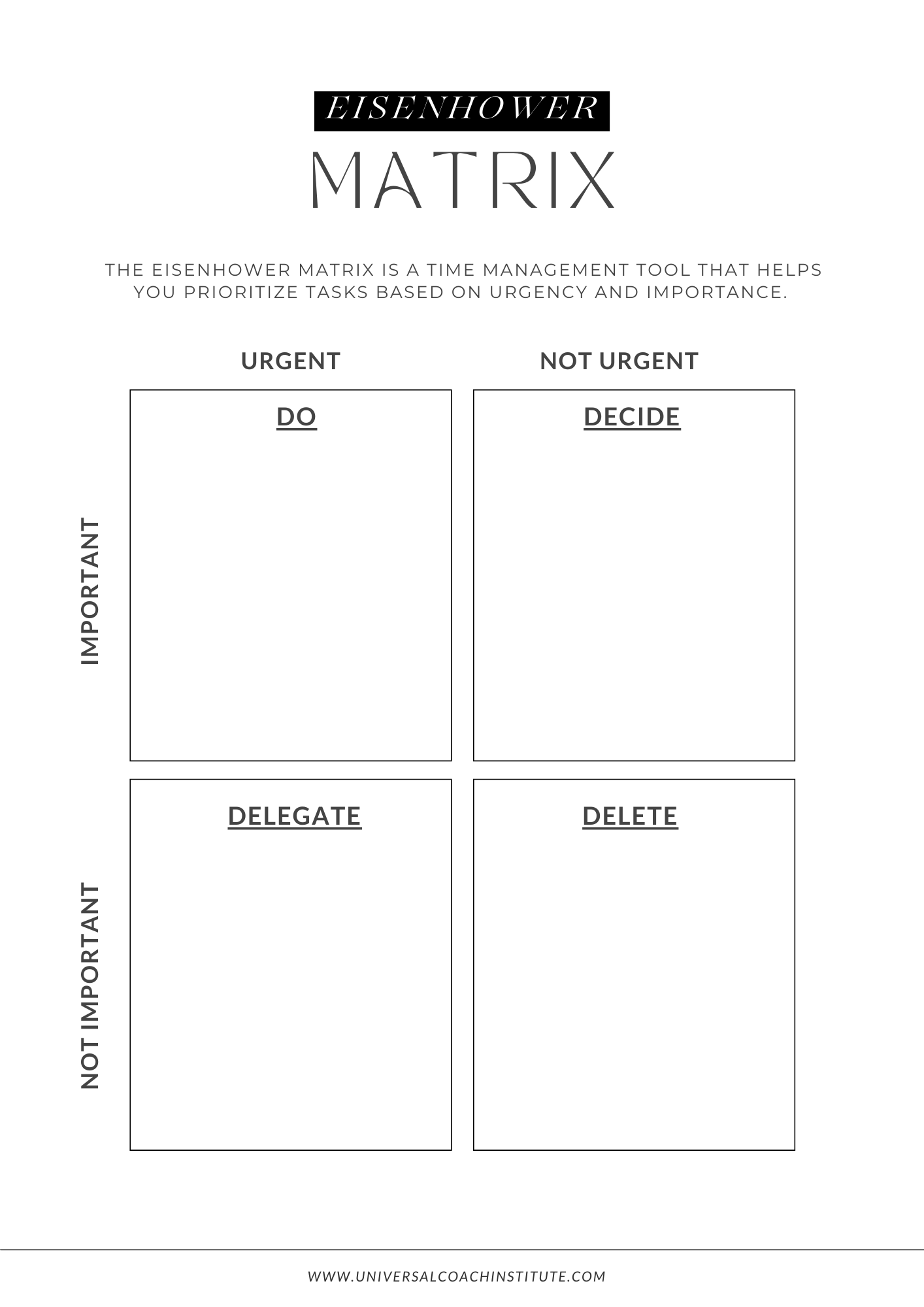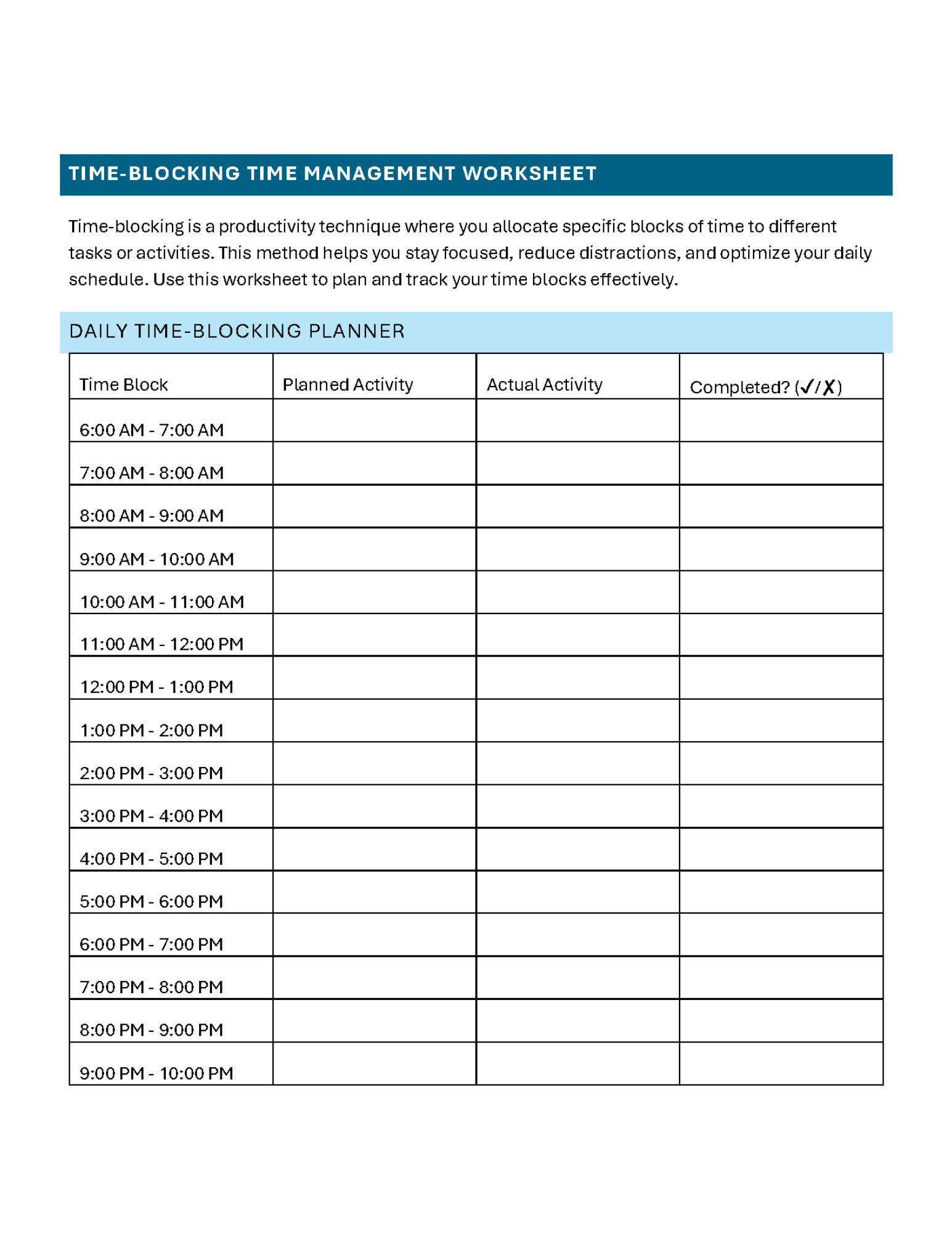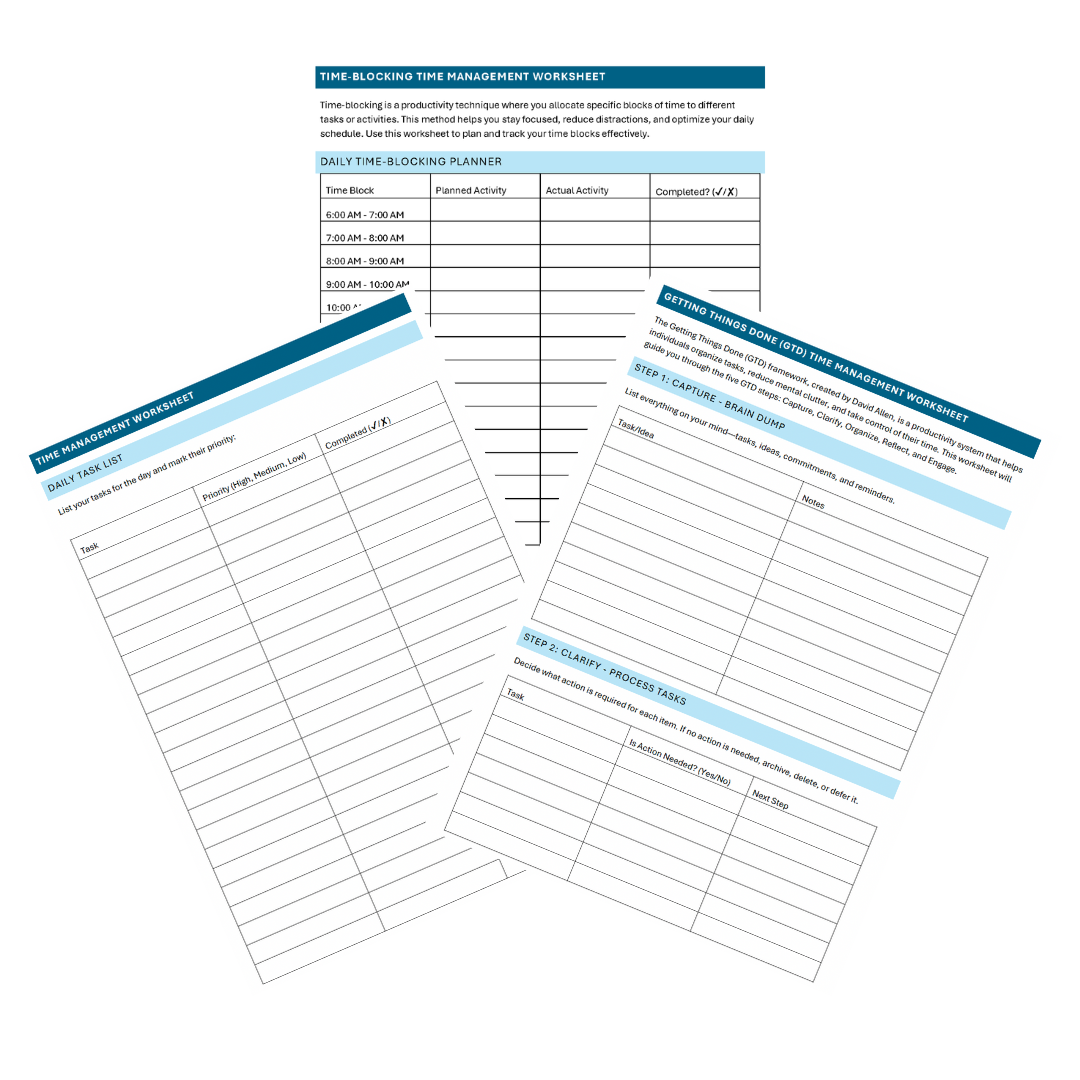Are you struggling to fit everything into your busy day? A time management worksheet might be just what you need to gain control over your schedule.
Using a time management worksheet helps you see how you spend your time. It can help you find activities that waste time. This way, you can create a more productive daily routine. These simple tools can transform how you approach your tasks and responsibilities.
What Is A Time Management Worksheet?
Time management worksheets are practical tools designed to help you organize your time, prioritize tasks, and increase productivity. They provide structure for planning your days, weeks, or months to maximize efficiency.
Key features often include:
- Task lists with priority indicators (A, B, C or High, Medium, Low)
- Time blocks for scheduling specific activities
- Goal-setting sections to align daily tasks with larger objectives
- Reflection areas to evaluate productivity
- Deadline trackers to monitor progress
Most time management worksheets use visual elements like grids, charts, or timelines to make planning more intuitive. They can be printed templates, digital documents, or specialized apps designed to help you gain control over your schedule.
Time Management Worksheet vs. Daily Planner – What’s The Difference?
While they seem similar, time management worksheets differ from daily planners in several important ways.
| Feature | Time Management Worksheet | Daily Planner |
|---|---|---|
| Purpose | Helps organize and track time effectively | Primarily for scheduling appointments and notes |
| Structure | Breaks tasks into priority levels and time blocks | More flexible and open-ended |
| Best For | Productivity, efficiency, and tracking progress | General planning and journaling |
You might use both tools together—worksheets to improve your time management skills and planners to implement your improved system day-to-day.
When to Use a Time Management Worksheet?
Time management worksheets serve valuable purposes in various situations where maximizing productivity matters.
Professional Settings:
- Project planning and deadline management
- Balancing multiple responsibilities at work
- Tracking billable hours and client work
Academic Environments:
- Scheduling study sessions for different subjects
- Planning for exams and assignment deadlines
- Balancing coursework with extracurricular activities
Personal Development:
- Analyzing where your time goes throughout the day
- Creating better work-life balance
- Building new habits by allocating specific time blocks
The flexibility of these worksheets makes them useful tools for anyone looking to gain better control over their time.
What are the Benefits of Using a Time Management Worksheet?
Time management worksheets are powerful tools that transform how you organize your day and accomplish tasks. They offer concrete advantages that directly impact your productivity and well-being.
Helps Prioritize Important vs. Urgent Tasks
Time management worksheets help you distinguish between what’s truly important and what merely seems urgent. By categorizing tasks, you can focus on high-impact activities instead of just responding to whatever demands attention first.
Prevents Overwhelm & Reduces Stress
A time management worksheet breaks down large projects into manageable steps. This simple act transforms intimidating workloads into achievable tasks.
When everything is captured on paper (or digitally), your brain no longer needs to keep track of all your commitments. This mental offloading significantly reduces stress and anxiety about forgetting important deadlines. This reduction in mental clutter also leads to improved focus and better sleep.
Creates Work-Life Balance by Structuring Your Time
Time management worksheets help establish boundaries between work and personal life. By allocating specific hours for different activities, you ensure important life areas don’t get neglected.
Tracks Productivity Over Time for Continuous Improvement
Time management worksheets create a record of how you spend your days. This data becomes valuable for identifying patterns and making improvements.
Your time log reveals:
- Peak productivity periods (When do you accomplish the most?)
- Time-wasting activities (What consumes hours without results?)
- Project completion rates (How accurately do you estimate task duration?)
By reviewing your worksheets weekly, you gain insights about your work habits. The worksheet transforms from a daily tool into a coaching system. It helps you continuously refine your approach to time management.
Supports Habit Formation & Daily Routines
Time management worksheets reinforce positive habits by adding structure and accountability. Scheduling tasks increases follow-through, while checking them off boosts motivation. Tracking consistency over time helps make productive behaviors automatic. This leads to lasting improvements in productivity and well-being.
Popular Time Management Methods & How They Relate To A Worksheet
Time management methods provide structure to your daily planning efforts. You can easily add these proven systems to worksheets. They will help you prioritize tasks, focus your energy, and get more done.
Eisenhower Matrix
The Eisenhower Matrix divides tasks into four quadrants based on their urgency and importance. On your worksheet, create a 2×2 grid with these categories:
- Urgent and Important – Do these tasks immediately
- Important but Not Urgent – Schedule these tasks
- Urgent but Not Important – Delegate these tasks
- Neither Urgent nor Important – Eliminate these tasks
This visual method helps you quickly assess where to focus your attention. When using this on your worksheet, assign each task to its appropriate quadrant.
You’ll notice patterns emerging over time – if you’re constantly in the “urgent/important” quadrant, you might need better planning. A well-designed worksheet gives you space to evaluate each task before assigning it to a quadrant.
 Download the Eisenhower Matrix Worksheet
Download the Eisenhower Matrix Worksheet
Pomodoro Technique
The Pomodoro Technique uses timed work sessions, usually 25 minutes long, followed by short breaks. This helps you stay focused and avoid burnout. Your time management worksheet can incorporate this method by:
- Creating space to list tasks you’ll complete during each Pomodoro session
- Including checkboxes to track completed Pomodoros
- Designating areas to note insights about your focus during sessions
A Pomodoro worksheet could have a simple timer. You can mark an X for each session you complete. This visual representation helps you see your productivity patterns.
You can also add a small section to record distractions that arise during your Pomodoro sessions. Tracking these interruptions allows you to address recurring issues that affect your concentration.
![]() Download Pomodoro Time Management Worksheet
Download Pomodoro Time Management Worksheet
Parkinson’s Law
Parkinson’s Law states that “work expands to fill the time available for its completion.” Your worksheet can combat this tendency by encouraging:
- Setting specific, shorter deadlines for tasks
- Tracking actual completion time vs. estimated time
- Reviewing patterns of time estimation accuracy
A worksheet section dedicated to Parkinson’s Law might include columns for “Estimated Time” and “Actual Time” for each task. This comparison helps you become more realistic about time requirements.
You can also add a constraint section where you deliberately limit resources (time, tools, etc.) to encourage efficiency. Many people find they work more effectively with reasonable constraints rather than open-ended timeframes.
 Download Parkinson’s Law Time Management Worksheet
Download Parkinson’s Law Time Management Worksheet
Time-Blocking
Time-blocking involves assigning specific time periods to certain activities or tasks. A time-blocking worksheet typically features:
- An hourly calendar layout (from your waking hour to bedtime)
- Color-coding for different types of activities
- Buffer zones between blocks for transition time
When creating your worksheet, leave room to review how well you adhered to your time blocks. Did you finish tasks in their allotted time? Were there interruptions?
You can improve your time-blocking worksheet by adding a section for “theme days.” This means setting aside specific days for certain types of work. For example, Monday for planning, Tuesday for meetings, etc. This reduces context-switching costs.
 Download Time Blocking Time Management Worksheet
Download Time Blocking Time Management Worksheet
Getting Things Done (GTD) Framework
The GTD framework focuses on capturing, clarifying, organizing, reflecting on, and engaging with your tasks. A GTD-inspired worksheet includes:
- An “inbox” section to capture random thoughts and to-dos
- A “next actions” area for immediate tasks
- A “waiting for” section to track delegated items
- A “someday/maybe” list for future ideas
Your worksheet should provide clear pathways to move items from capture to completion. Include regular review prompts to ensure nothing falls through the cracks.
GTD worksheets work best when they include simple decision trees. For each captured item, ask: “Is this actionable?” If yes, determine the next step; if no, decide whether to trash it, reference it, or incubate it for later review.
 Download the GTD Framework Time Management Worksheet
Download the GTD Framework Time Management Worksheet
Download Your Free Printable Time Management Worksheet
Get organized today with our helpful time management worksheet. It helps you track tasks, set priorities, and use your day wisely. This free resource is ready to download and can be customized to fit your unique schedule.
What’s Included In The Worksheet?
The time management worksheet contains several useful elements to boost your productivity:
- Daily Task List – Space to write down all your tasks with priority markers
- Time Blocking Grid – 30-minute intervals to plan your day from morning to evening
- Eisenhower Matrix – Sort tasks by importance and urgency
- Activity Log – Track how you actually spend time compared to your plan
- Goal Setting Section – Link daily tasks to weekly and monthly goals
- Daily Planner – Schedule tasks and commitments for the day.
- Weekly Planner – Schedule tasks and commitments for the week.

Download the Time Management Worksheet
The worksheet has a quick-reference checklist for regular tasks. It also has a space to reflect on what worked well. You’ll find a progress tracker to celebrate completed tasks and identify patterns in your productivity throughout the week.
How To Use A Time Management Worksheet Effectively
Using a time management worksheet requires a systematic approach to capture your activities, prioritize tasks, and allocate your hours wisely. The right method transforms a simple worksheet into a powerful tool for productivity.
Step 1: Identify Your Priorities
Start by listing everything you need to accomplish. Create three categories: urgent and important, important but not urgent, and neither urgent nor important. This clarity helps you focus on what truly matters.
When setting priorities, connect them to your long-term goals. Ask yourself, “Does this task move me closer to my objectives?” If not, consider delegating or eliminating it.
Use bold headers on your worksheet to mark high-priority items. This visual cue draws your attention to critical tasks when you review your schedule.
Your time budget should reflect your priorities. Allocate more time to activities that align with your personal and professional goals. Remember that effective planning isn’t about doing everything—it’s about doing the right things.
Step 2: Break Down Large Tasks Into Actionable Steps
Convert overwhelming projects into manageable chunks. Instead of writing “complete report,” list specific actions like “research statistics” or “draft introduction.”
Each action item should be:
- Clear and specific
- Achievable in one sitting
- Measurable for completion
Breaking down tasks provides psychological benefits too. Your brain releases dopamine when you check off completed items, motivating you to continue.
Use bullet points or numbered lists on your worksheet for these smaller steps. This format makes tracking progress easier and provides a visual roadmap of your workflow.
Estimate how long each step might take. This practice improves your time estimation skills and prevents the common mistake of underestimating task duration.
Step 3: Assign Time Slots
Block specific hours for each task in your daily time management plan. Be realistic about duration—most people underestimate how long things take.
Consider your energy levels when scheduling. Place complex tasks during your peak productivity hours. Save routine activities for when your energy naturally dips.
Include buffer time between appointments. This padding accounts for unexpected delays and prevents cascading schedule failures.
Your weekly schedule should balance focused work with breaks. Research shows the optimal pattern is 52 minutes of concentration followed by a 17-minute break.
Color-code different types of activities on your worksheet:
- Blue: deep work requiring focus
- Green: meetings and collaboration
- Yellow: administrative tasks
- Red: personal time and self-care
Step 4: Track & Adjust Your Productivity Daily
Record how you actually spend your time compared to your plan. Note where you lost focus or encountered unexpected obstacles.
Use simple tracking codes on your worksheet:
- ✓ = Completed as planned
- → = Moved to another day
- ½ = Partially completed
- X = Canceled or didn’t happen.
Be honest about distractions. If social media consumed 30 minutes of your planned work time, document it. This awareness is the first step toward improvement.
Adjust your plan as the day unfolds. Time management isn’t rigid—it’s responsive. If an urgent matter arises, decide consciously what to postpone and update your worksheet accordingly.
End each day by preparing tomorrow’s worksheet with lessons learned. This creates a virtuous cycle of continuous improvement.
Step 5: Reflect & Optimize Weekly For Better Efficiency
Schedule a 30-minute weekly review of your time management patterns. Look for activities that consistently take longer than expected or tasks you regularly postpone.
Calculate your planning accuracy by comparing estimated versus actual time spent. This metric improves with practice and helps you become more realistic in your scheduling.
Identify your productivity trends:
- When are you most focused?
- Which tasks drain your energy?
- Where do you consistently underestimate time needed?
Experiment with different worksheet formats and planning approaches based on your findings. Some people thrive with hourly schedules; others prefer task-based planning.
Celebrate wins and progress. Note which strategies worked well and replicate them in the coming week’s plan. This positive reinforcement builds momentum in your time management practice.
Frequently Asked Questions
1. How Can I Combine a Time Management Worksheet with Digital Tools?
You can digitize your worksheet using Google Docs, Notion, or Excel for easy editing. Sync tasks with Google Calendar or Todoist for reminders and automated scheduling. Use project management apps like Trello or ClickUp to track progress visually.
2. What Are the Best Apps to Use Alongside a Time Management Worksheet?
- Google Calendar – Schedule tasks and set reminders.
- Notion – Organize tasks, notes, and project plans.
- Trello – Create visual task boards for workflow tracking.
- Todoist – Manage daily to-do lists with priority levels.
- RescueTime – Monitor time usage and improve productivity.
3. Which Works Best – Daily vs. Weekly Planning?
Daily planning is great for detailed task management and short-term goals. Weekly planning helps with long-term priorities and bigger projects. The best approach combines both—set weekly goals and break them into daily tasks.
4. How Can I Stay Consistent & Make Time Management a Habit?
- Set a daily planning routine (morning or evening).
- Use reminders in calendar apps to review tasks.
- Keep your worksheet visible (printed or digital).
- Reflect weekly to adjust and improve strategies.
- Start small—consistency builds over time!
Take Away
Time management isn’t just about squeezing more tasks into your day. It’s about taking control of your time to achieve what matters most to you. The time management worksheet serves as your personal roadmap to more productive days and reduced stress.
The time management worksheet delivers several immediate benefits to your daily routine. You’ll gain clarity on your true priorities rather than just responding to whatever seems urgent.



